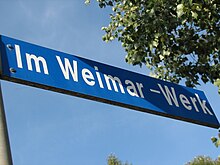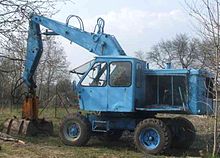Weimar factory

The VEB Weimar factory belonged before the VEB Weimar watch movement to the two nationally known and job most large industrial company in Weimar and was north central station located along the Buttelstedter road.
The Weimar factory made a name for itself in 1953 as a combine harvester factory - it was one of the largest industrial farms in agricultural machinery in the GDR . From 1970 to 1978 the company had the status of a combine with the name Weimar Combine. In its heyday, the Weimar plant had around 4,800 employees in the main plant.
history
The origin of the company was the "Waggonfabrik Weimar AG" founded in 1898. After changing hands several times, this company mainly produced armaments from the mid-1930s. After the war-related destruction and dismantling, the company began in 1946 as a SAG company with the repair of wagons and the production and consumer goods. In the following period, the focus was on wagon construction. In 1952 the company with around 3,500 employees was transferred to public ownership under the name VEB LOWA Waggonbau Weimar .
In 1953, the company was assigned to the agricultural machinery manufacturing department and renamed " VEB Mähdrescherwerk Weimar". In 1954 the production of combine harvesters as well as potato and beet harvesting machines began, initially on the basis of Soviet documentation. There were also grass mowers and rakes.
From the mid-1950s, the company focused on the development and production of potato harvesting technology and loaders. At the beginning of the 1960s, the machines and equipment for potato processing and storage were added. As a result, combine harvester production in Weimar was discontinued in 1962. As early as 1960, the production of combine harvesters was in progress in the combine progress agricultural machinery , Singwitz plant . In 1964 the company was renamed “VEB Weimar-Werk”.
In 1970, in connection with the merger of agricultural and food machinery construction, the Weimar Combine was formed and profiled for the following machine systems:
- Tillage, cultivation, fertilization, plant protection
- Potato harvest, processing and storage
- Beet harvest
In addition to the companies concerned from VVB Landmaschinenbau, other, primarily small and medium-sized companies in the agricultural machinery and supplier industry were assigned to this combine. In 1970 the Weimar Kombinat had 21 companies with a total of around 11,000 employees, around 4,800 of them in the Weimar factory.
In the period that followed, other companies, including former private or semi-public companies in the agricultural machinery and supplier sector, were assigned to the combine, including VEB Landmaschinenbau Halberstadt (formerly Dehne). The private companies had previously been transferred to public ownership.
With the formation of the Combine Progress Agricultural Machinery in 1978, the Weimar Combine with its approximately 15,000 employees was dissolved. The Weimar-Werk, which at that time had around 5,700 employees with its parts of the business, was simultaneously assigned managerial tasks for a further nine legally independent companies of the combination progress agricultural machinery with a total of around 4,200 employees.
In the mid-1980s, some of these holdings were converted into business units and / or assigned to other combine operations. As a result of these measures, the Weimar factory had around 6,400 employees at the end of the 1980s, of which around 1,600 were employed in the Halberstadt, St. Egidien, Lobenstein, Apolda, Auma and Buttstädt parts of the company. The turnover was around 930 million GDR marks.
On April 30, 1990, the Weimar-Werk withdrew from the association of the combine progress agricultural machinery. Under the following trust administration, the company was divided into several independent economic units with the aim of privatization with a promising future. None of the companies that followed the product profile of the Weimar factory survived. The last liquidations took place in 1997.
Establishments
With the formation of the combine, only a few centralized management and service units were created for this economic unit in Weimar. In essence, a group-like organization and management was practiced with extensive independence of the combine operations.
The most important companies of the Weimar combine
- Weimar factory
- Institute for Agricultural Engineering Leipzig
- Soil tillage equipment factory in Leipzig
- Agricultural machinery manufacturer Torgau
- Agricultural machinery construction Bernburg
- Agricultural machinery construction Döbeln
- Agricultural machinery manufacturer Güstrow
- Agricultural machinery Auma
- Agricultural machinery construction Halberstadt
- Progress St. Egidien
- Agricultural machinery manufacturing large company
- Zella-Mehlis Meteor Plant
- Fire extinguishing equipment factory in Apolda
- Hydrauflex Plauen
Products
In addition to the grass mowers, rakes and rakes for teams, which were still produced until 1958, the products were from the 1950s
- Combine harvester E 171 according to Soviet documentation from 1954 and the modified in-house development E 173 and E 175 from 1955
- 2-row potato harvester E 671 according to Soviet documentation from 1954 and the in-house development E 372 from 1958
- Self-propelled loader T 170 from 1957

Products from the 1960s and 1970s:
- 2-row potato harvester E 675 from 1960 and the modular system E 665 with 25 variants from 1964
- Self-propelled loader T 172 from 1960, T 174/1 from 1967 and T 174/2 from 1971
- Production of 61 sets of the SZ 24 cable pulling unit in 1960/1961, the diesel engine variant of a two-engine steam cable plow
- Development and production of the amelioration technology mole draining machine B 750, self-propelled trench clearing machine B 770 and self-propelled trench excavator B 771 in the years 1961 to 1964
- Machines and equipment for the stationary processing of potatoes with the roller inspection table K 711 from 1966 and for potato warehouses with the corresponding sorting, fractionation and picking technology as well as the automatic separating device for potatoes, clods and stones K 691 from 1977
- 2- and 3-row toboggan loaders E 682 and E 684 from 1977 and the 3-row self-propelled potato harvester E 688 from 1978
Main products of the 1980s:
- 2-row potato harvesting loader E 686 from 1981 and 1-row potato harvesting loader E 689 from 1982
- Mobile loader / excavator T 188 from 1983
- Barn work machine HT 140 from 1984
- 2-row potato harvesting loader E 686 with electronically controlled admixture separation from 1987
In the period 1970 to 1978 (existence of the Weimar Combine) the following agricultural engineering programs were added:
- Soil cultivation technology (programs of the Leipzig and Torgau companies)
- Sowing technology (program of the Bernburg company)
- Fertilization technology (program of the Güstrow and Döbeln companies)
- Plant protection technology (program of the Leipzig plant, which was relocated to Hungary in 1973)
- Beet harvesting technology (programs of the Leipzig, Torgau and Döbeln companies, which from the mid-1970s were limited to assembly production for the self-propelled toboggan loader KS 6 with final production in the Ukraine)
The focus of the supplier programs during this period was:
- Roller chains (program of the Zella-Mehlis company)
- Hydraulic hoses (program of the Plauen company)
- Steel bottles (program of the Apolda company)
Apprenticeship training
The Thüringische Landeszeitung reported on August 21, 2014 with the headline "50 years in the Weimar-Werk" about a worker (64) who was retiring at the end of the month and whose professional life is exemplary for similar Weimar-Werk résumés: September 1, 1964 she started her three-year training in what was then the first metal class at VEB Weimar-Werk - as one of 300 apprentices who completed the 9th and 10th grades at the same time as the apprenticeship. The young person learned the trade of a lathe operator - female job titles were not common at the time. The vocational school was in a barrack, where the employee parking lot of Hydrema Produktion GmbH is today. The training workshop was in the lower plant next to the “Red October” hall. At that time, the E 649 sieve chain luge loader and the T 172 mobile excavator were manufactured in the factory. After her apprenticeship, a groove milling machine was her workplace. In 1968 she began studying mechanical engineering: She was delegated to the Schmalkalden technical college for direct studies in “Technology”. She then worked as a technologist at the Weimar plant from 1971 to 1994. In 1995 the Treuhandanstalt operated the privatization; The Danish Hydrema took over parts of the site, which it still operates today - and the now pensioner can look back on 50 years of work in the Weimar factory and in a successor company.
Varia

The manufacturer of tin toys VEB (K) Metallspielwaren Weimar , which was also based in Weimar at the time, produced the T 172 self-loading excavator as a mechanical, scale toy controlled by delicate metal chains until 1964; the number of models produced is not known.
literature
- K. Krombholz: Agricultural machinery in the GDR - light and shadow . DLG-Verlag, Frankfurt / Main 2008, ISBN 978-3-7690-0717-6 .
- Collective of authors: The nationally owned combine progress agricultural machinery Neustadt in Saxony and its businesses 1945–1990 . Publication of the traditional association KOFO Neustadt / Sa. eV, Neustadt in Saxony 2005.
- H. Fischer, H.-J. Zöllner: 100 years of the Weimar factory as an industrial location - history of the Weimar factory . Self-published, Weimar 1998.
Individual evidence
- ↑ At the original address Buttelstedter Straße 4 there is now a Netto supermarket.
- ↑ Michael Baar: 50 years in the Weimar factory. Turner and technologist Regina Gang says goodbye. P. 16 in the Thüringische Landeszeitung, Weimar edition, August 21, 2014
Web links
Coordinates: 50 ° 59 ′ 33.7 ″ N , 11 ° 19 ′ 54.1 ″ E





